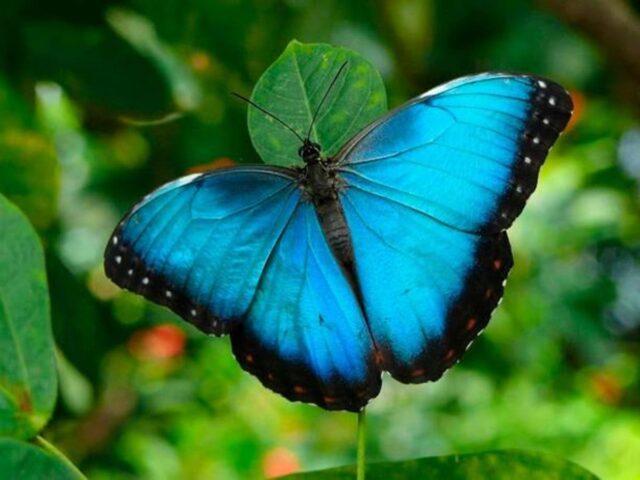Donald Arce taps a black cloth from the butterfly farm next to his home in Siquirres, Costa Rica. Some 300 “laying” blue morpho butterflies flutter and paint the environment vibrant blue. Soon, their young will do the same, on a trip around the world.
Arce is 44 years old and has dedicated half his life to the production of butterfly pupae, becoming one of the world’s largest breeders of the Morpho peleides species, which on the one hand is brown, which helps it camouflage itself, and iridescent blue of the other.
Producing between 2,000 and 2,500 pupae per week, the majority for export. The figure, according to Secsa and Butterfly Kingdom -two of the five exporting companies in the country-, places Arce as one of the main world producers of this species. Costa Rica is the main exporter of butterflies, a market in which other countries in the region such as Colombia, Ecuador and El Salvador also stand out.
In the tropical and humid Caribbean town of Siquirres, its butterflies feed on bananas and a concoction whose ingredients Arce keeps secret. In his butterfly farm he has “layers”, which he joins with the smaller males in a ratio of 4 to 1. Then he introduces the host plant, about 75 centimeters high and with some branches and leaves.
When it is filled with eggs, it is taken to the laboratory, where there are huge shelves marked with exact days and times of the process. “Here the eggs last 12 days,” says Arce, accompanied by his wife, daughter and son, who help him at work. “When the larvae hatch, they move to the field [a farm] until they cocoon [for a month] and return to the laboratory to be bagged,” he explains.

Arce looks for perfect specimens for which he makes sure that each cocoon is symmetrical, if it is not, he explains, it is discarded because the butterfly would be born disproportionate.
He packs them in small boxes with an inner cotton bed. Depending on the weather, the product has between 12 and 18 days to reach its recipient, before the butterflies hatch. Each cocoon is worth $ 2.10 if it is for export and $ 1.6 if it is for local consumption.
To Dubai
According to Sergio Siles, Secsa’s operations manager, there are approximately 100 producers in Costa Rica. Siles assures that the butterflies are used mostly in live exhibitions and, as their life cycle is only 45 days, the demand is sustained.
In Costa Rica, celebrations with massive releases are prohibited, as they alter ecosystems. In other countries the legislation may be different, and it depends on the exporter, Siles argues. He says that his company does not sell to those who do releases or experiments.
He also comments that the main destination of the pupa is the United States [38% according to official figures], followed by Europe. However, other markets have emerged such as the United Arab Emirates, Turkey, New Zealand or Dubai.
The state Foreign Trade Promoter indicates that from January to October 2021 the sector generated revenues for the country of 2.25 million dollars. Between 60,000 and 70,000 pupae of all species are exported monthly.
The Costa Rican Butterfly Kingdom butterfly farm, open to the public, also buys from Arce and in turn exports. “We have exported to Russia, Austria, Germany, the United Kingdom, the Netherlands and Chile. Usually customers make specific orders but with 40% morpho, which they cannot miss,” said one of its owners, Anabelle González.
Why Morpho?
Donald entered the business 20 years ago and did so as the traditional recipe indicates, producing various species. “At the age of three I realized it was better to specialize in one,” says Arce, who just finished elementary school and had agricultural work experience.
“We chose the morpho because, although it is the most difficult, it is the most attractive. It also has advantages: it does not stay still, it flies constantly and, as it is large (up to 15 centimeters from wing to wing), it does not take so many for a place seems crowded,” he explained.
But he had difficulties. Eight years ago a plague almost took away what was built. “For two years we did not produce anything. All the larvae died. We burned the butterfly farms, the laboratory, everything. And it kept happening. Then we realized that it was the water from the river that passes through here, that it had bacteria,” he explained. But Donald and his family overcame the problem, and their business flies again, like their butterflies.

